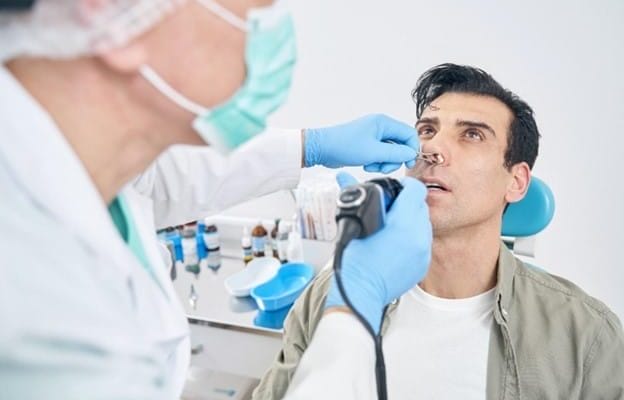The nasal turbinates are important structures within the nasal passageway that warm, humidify, and filter the air we breathe. Among these structures, the inferior turbinates are the largest and occupy the nasal cavities. They can sometimes cause breathing difficulties when they become enlarged. Inferior turbinate surgery aims to reduce the size of these structures, improving airflow and helping patients breathe easier.
What are the Inferior Turbinates?
The nasal cavity contains three pairs of elongated, slender bones covered with a flexible layer of tissue that has the ability to expand. These structures are known as nasal turbinates. The inferior turbinate is the largest among the three pairs. The main functions of the inferior nasal turbinates include warming and humidifying the air, as well as guiding air into the nasal cavity.
When the inferior turbinate becomes enlarged or inflamed—a condition called inferior turbinate hypertrophy—it can obstruct the nasal passage and cause nasal congestion. The management of inferior turbinate hypertrophy typically involves the use of topical intranasal corticosteroid sprays, oral antihistamines, and topical antihistamines. In some cases, conservative treatments may not provide sufficient relief, and surgical intervention may be warranted.
When is Inferior Turbinate Surgery Needed?
Inferior turbinate surgery may be considered when a person has chronic nasal obstruction from inferior turbinate hypertrophy that does not respond to medications such as nasal steroid sprays or allergy management. Allergic rhinitis, non-allergic rhinitis, and environmental irritants can cause the inferior turbinates to swell, leading to nasal breathing issues.
There are several surgical techniques used to address this issue:
- Turbinectomy: A portion of the turbinate is removed.
- Turbinoplasty: The bone within the turbinate is reshaped.
- Radiofrequency reduction: Heat energy is used to shrink the turbinate tissue.
- Submucosal resection: The bone and mucosal lining are left intact while the submucosal soft tissue is reduced.
Procedure
The surgery is performed by an otolaryngologist (ear, nose, and throat specialist) and can be done under local or general anesthesia. The specific technique used may vary depending on the patient’s condition and the surgeon’s preference. The goal is always to improve breathing while preserving enough turbinate tissue to maintain normal nasal function.
Recovery and Follow-Up Care
After undergoing inferior turbinate surgery, proper recovery and follow-up care are crucial for a successful outcome. Here are some key points to keep in mind:
- Nasal congestion and discharge: It is normal to experience nasal congestion, discharge, and occasional bleeding in the days following the surgery. This should gradually improve over time.
- Pain management: Your doctor may prescribe pain medication to help manage any discomfort you may experience during the recovery period. Follow their instructions carefully.
- Rest and recovery: It is essential to rest and avoid strenuous activities for the first few days after surgery. This will allow your body time to heal properly.
- Follow-up appointments: Your doctor will schedule follow-up appointments to monitor your progress and remove any nasal packing or splints if necessary.
- Long-term care: To maintain the benefits of the surgery and prevent future complications, it is important to follow your doctor’s postoperative care instructions, including using saline nasal rinses as recommended.
Risks and Complications
As with any surgical procedure, there are risks and potential complications associated with inferior turbinate surgery, including bleeding, infection, scarring, changes in nasal airflow, or need for further surgery.
Conclusion
Inferior turbinate surgery may be necessary for individuals with chronic nasal congestion or obstruction that does not respond to other treatments. It is a procedure designed to reduce the size of the inferior turbinates in order to improve airflow through the nasal passages. It can provide long-term relief for those suffering from persistent nasal congestion. It is important to consult with a qualified ENT specialist or rhinologist to determine if inferior turbinate surgery will help you.
SinusHealth is dedicated to promoting excellent patient care through the delivery of accurate information. For further insight into nasal and sinus surgeries, we invite you to visit the SinusHealth website. Our board-certified otolaryngologists offer reliable expertise on nasal and sinus conditions and treatment options. Please feel free to reach out to us for assistance in locating a rhinologist.

